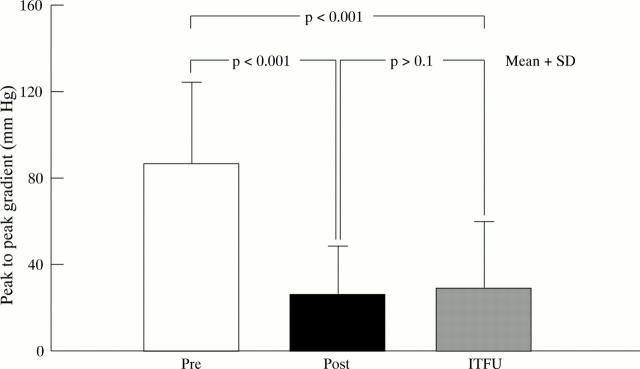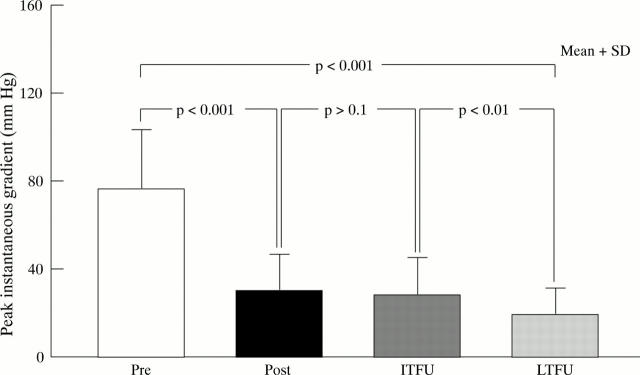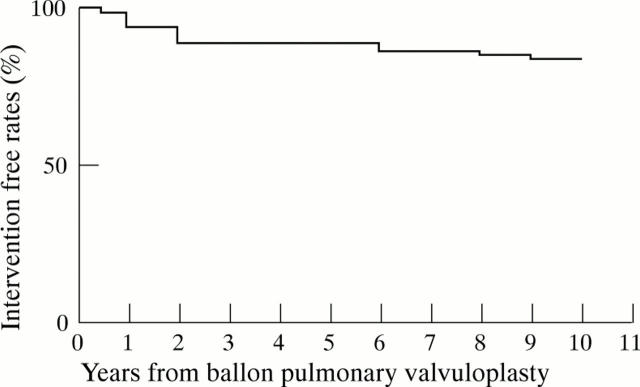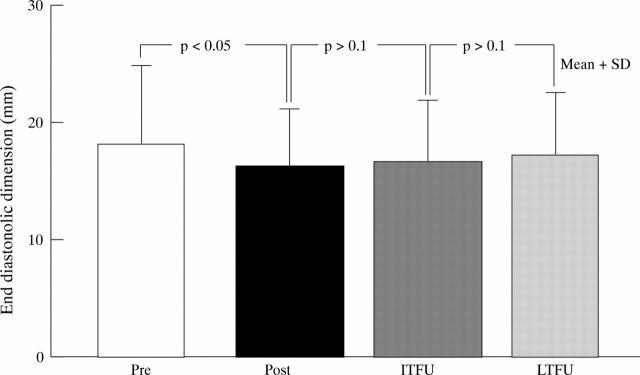Abstract
Background—The results of immediate and short term follow up of balloon dilatation of the pulmonary valve have been well documented, but there is limited information on long term follow up. Objective—To evaluate the results of three to 10 year follow up of balloon dilatation of the pulmonary valve in children and adolescents. Setting—Tertiary care centre/university hospital. Design—Retrospective study. Methods and results—85 patients (aged between 1 day and 20 years, mean (SD) 7.0 (6.4) years) underwent balloon dilatation of the pulmonary valve during an 11 year period ending August 1994. There was a resultant reduction in the peak to peak gradient from 87 (38) to 26 (22) mm Hg. Immediate surgical intervention was not required. Residual gradients of 29 (17) mm Hg were measured by catheterisation (n = 47) and echo Doppler (n = 82) at intermediate term follow up (two years). When individual results were scrutinised, nine of 82 patients had restenosis, defined as a peak gradient of 50 mm Hg or more. Seven of these patients underwent repeat balloon dilatation of the pulmonary valve: peak gradients were reduced from 89 (40) to 38 (20) mm Hg. Clinical evaluation and echo Doppler data of 80 patients showed that residual peak instantaneous Doppler gradients were 17 (15) mm Hg at long term follow up (three to 10 years, median seven), with evidence for late restenosis in one patient (1.3%). Surgical intervention was necessary to relieve fixed infundibular stenosis in three patients and supravalvar pulmonary stenosis in one. Repeat balloon dilatation was performed to relieve restenosis in two patients. Actuarial reintervention free rates at one, two, five, and 10 years were 94%, 89%, 88%, and 84%, respectively. Pulmonary valve regurgitation was noted in 70 of 80 patients at late follow up, but neither right ventricular dilatation nor paradoxical interventricular septal motion developed. Conclusions—The results of late follow up of balloon dilatation of the pulmonary valve are excellent. Repeat balloon dilatation was performed in 11% of patients and surgical intervention for subvalvlar or supravalvar stenosis in 5%. Most patients had mild residual pulmonary regurgitation but right ventricular volume overload did not develop and surgical intervention was not required. Balloon dilatation is the treatment of choice in the management of moderate to severe stenosis of the pulmonary valve. Further follow up studies should be undertaken to evaluate the significance of residual pulmonary regurgitation. Keywords: balloon dilatation of the pulmonary valve; pulmonary stenosis; pulmonary regurgitation
Full Text
The Full Text of this article is available as a PDF (106.2 KB).
Figure 1 .
Mean (SD) peak to peak systolic pressure gradients measured at cardiac catheterisation before (Pre) and after (Post) balloon dilatation of the pulmonary valve. There is a significant decrease (p < 0.001) immediately following dilatation. The gradient measured during repeat catheterisation in 47 patients at intermediate term follow up (ITFU) is unchanged (p > 0.1) compared with the gradient immediately after dilatation and continues to be lower (p < 0.001) than the gradient before dilatation.
Figure 2 .
Mean (SD) maximum peak instantaneous Doppler gradients measured before (Pre) and one day after (Post) balloon dilatation of the pulmonary valve and at intermediate(ITFU) and late (LTFU) term follow up. There is a reduction (p < 0.001) after dilatation that remains unchanged (p > 0.1) at ITFU. At LTFU, however, there was further fall (p < 0.01).
Figure 3 .
Actuarial event free rates after balloon dilatation of the pulmonary valve. Reintervention free rates at one, two, five, and 10 years are 94%, 89%, 88%, and 84%, respectively.
Figure 4 .
Right ventricular end diastolic dimensions before (Pre) and one day after (Post) balloon dilatation of the pulmonary valve and at intermediate (ITFU) and late (LTFU) term follow up. There was a significant decrease (p < 0.05) in right ventricular size immediately following balloon dilatation. There was no further change at ITFU and LTFU.
Figure 5 .
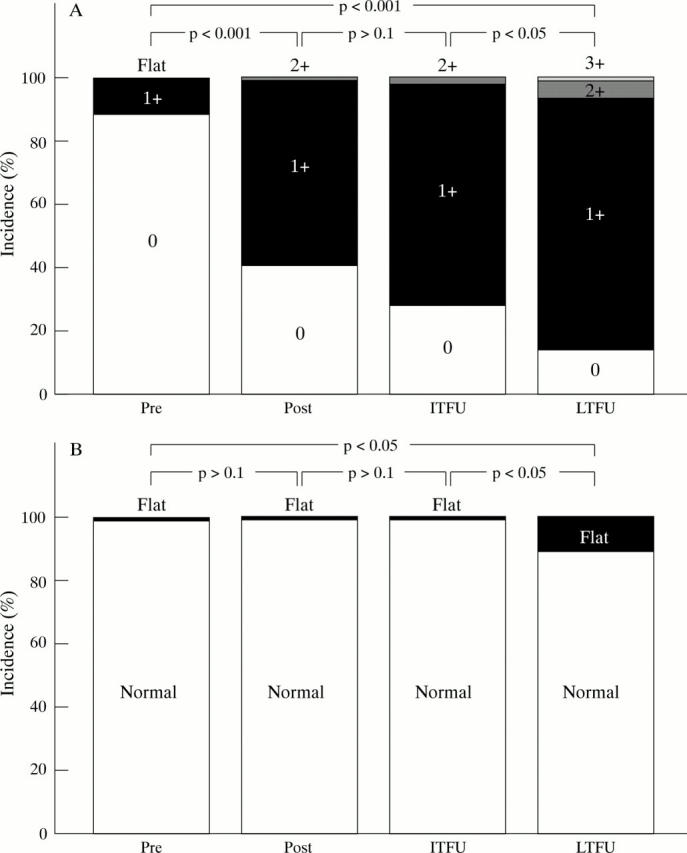
(A) Doppler graded (table) pulmonary regurgitation before (Pre) and one day after (Post) balloon dilatation of the pulmonary valve and at intermediate (ITFU) and late (LTFU) term follow up. There is a gradual but significant increase (p < 0.05 to p < 0.001) in the incidence of pulmonary regurgitation. (B) Nature of interventricular septal motion. There is a significant increase (p < 0.05) in the incidence of flat septal motion at LTFU. None of the patients had paradoxical septal motion.
Selected References
These references are in PubMed. This may not be the complete list of references from this article.
- Gutgesell H. P., Rembold C. M. Growth of the human heart relative to body surface area. Am J Cardiol. 1990 Mar 1;65(9):662–668. doi: 10.1016/0002-9149(90)91048-b. [DOI] [PubMed] [Google Scholar]
- Kan J. S., White R. I., Jr, Mitchell S. E., Anderson J. H., Gardner T. J. Percutaneous transluminal balloon valvuloplasty for pulmonary valve stenosis. Circulation. 1984 Mar;69(3):554–560. doi: 10.1161/01.cir.69.3.554. [DOI] [PubMed] [Google Scholar]
- Kan J. S., White R. I., Jr, Mitchell S. E., Gardner T. J. Percutaneous balloon valvuloplasty: a new method for treating congenital pulmonary-valve stenosis. N Engl J Med. 1982 Aug 26;307(9):540–542. doi: 10.1056/NEJM198208263070907. [DOI] [PubMed] [Google Scholar]
- Lababidi Z., Wu J. R. Percutaneous balloon pulmonary valvuloplasty. Am J Cardiol. 1983 Sep 1;52(5):560–562. doi: 10.1016/0002-9149(83)90026-7. [DOI] [PubMed] [Google Scholar]
- McCrindle B. W., Kan J. S. Long-term results after balloon pulmonary valvuloplasty. Circulation. 1991 Jun;83(6):1915–1922. doi: 10.1161/01.cir.83.6.1915. [DOI] [PubMed] [Google Scholar]
- Mullins C. E., Nihill M. R., Vick G. W., 3rd, Ludomirsky A., O'Laughlin M. P., Bricker J. T., Judd V. E. Double balloon technique for dilation of valvular or vessel stenosis in congenital and acquired heart disease. J Am Coll Cardiol. 1987 Jul;10(1):107–114. doi: 10.1016/s0735-1097(87)80168-7. [DOI] [PubMed] [Google Scholar]
- O'Connor B. K., Beekman R. H., Lindauer A., Rocchini A. Intermediate-term outcome after pulmonary balloon valvuloplasty: comparison with a matched surgical control group. J Am Coll Cardiol. 1992 Jul;20(1):169–173. doi: 10.1016/0735-1097(92)90154-f. [DOI] [PubMed] [Google Scholar]
- Radtke W., Keane J. F., Fellows K. E., Lang P., Lock J. E. Percutaneous balloon valvotomy of congenital pulmonary stenosis using oversized balloons. J Am Coll Cardiol. 1986 Oct;8(4):909–915. doi: 10.1016/s0735-1097(86)80434-x. [DOI] [PubMed] [Google Scholar]
- Rao P. S. Balloon pulmonary valvuloplasty: a review. Clin Cardiol. 1989 Feb;12(2):55–74. doi: 10.1002/clc.4960120202. [DOI] [PubMed] [Google Scholar]
- Rao P. S., Brais M. Balloon pulmonary valvuloplasty for congenital cyanotic heart defects. Am Heart J. 1988 May;115(5):1105–1110. doi: 10.1016/0002-8703(88)90083-x. [DOI] [PubMed] [Google Scholar]
- Rao P. S. Doppler ultrasound in the prediction of transvalvar pressure gradients in patients with valvar pulmonary stenosis. Int J Cardiol. 1987 May;15(2):195–203. doi: 10.1016/0167-5273(87)90315-9. [DOI] [PubMed] [Google Scholar]
- Rao P. S., Fawzy M. E., Solymar L., Mardini M. K. Long-term results of balloon pulmonary valvuloplasty of valvar pulmonic stenosis. Am Heart J. 1988 Jun;115(6):1291–1296. doi: 10.1016/0002-8703(88)90023-3. [DOI] [PubMed] [Google Scholar]
- Rao P. S. Further observations on the effect of balloon size on the short term and intermediate term results of balloon dilatation of the pulmonary valve. Br Heart J. 1988 Dec;60(6):507–511. doi: 10.1136/hrt.60.6.507. [DOI] [PMC free article] [PubMed] [Google Scholar]
- Rao P. S. Indications for balloon pulmonary valvuloplasty. Am Heart J. 1988 Dec;116(6 Pt 1):1661–1662. doi: 10.1016/0002-8703(88)90790-9. [DOI] [PubMed] [Google Scholar]
- Rao P. S. Influence of balloon size on short-term and long-term results of balloon pulmonary valvuloplasty. Tex Heart Inst J. 1987 Mar;14(1):57–61. [PMC free article] [PubMed] [Google Scholar]
- Rao P. S., Thapar M. K., Kutayli F. Causes of restenosis after balloon valvuloplasty for valvular pulmonary stenosis. Am J Cardiol. 1988 Nov 1;62(13):979–982. doi: 10.1016/0002-9149(88)90909-5. [DOI] [PubMed] [Google Scholar]
- Rao P. S. Transcatheter treatment of pulmonary outflow tract obstruction: a review. Prog Cardiovasc Dis. 1992 Sep-Oct;35(2):119–158. doi: 10.1016/0033-0620(92)90003-i. [DOI] [PubMed] [Google Scholar]
- Rao P. S., Wilson A. D., Thapar M. K., Brais M. Balloon pulmonary valvuloplasty in the management of cyanotic congenital heart defects. Cathet Cardiovasc Diagn. 1992 Jan;25(1):16–24. doi: 10.1002/ccd.1810250105. [DOI] [PubMed] [Google Scholar]
- Thapar M. K., Rao P. S. Significance of infundibular obstruction following balloon valvuloplasty for valvar pulmonic stenosis. Am Heart J. 1989 Jul;118(1):99–103. doi: 10.1016/0002-8703(89)90078-1. [DOI] [PubMed] [Google Scholar]



